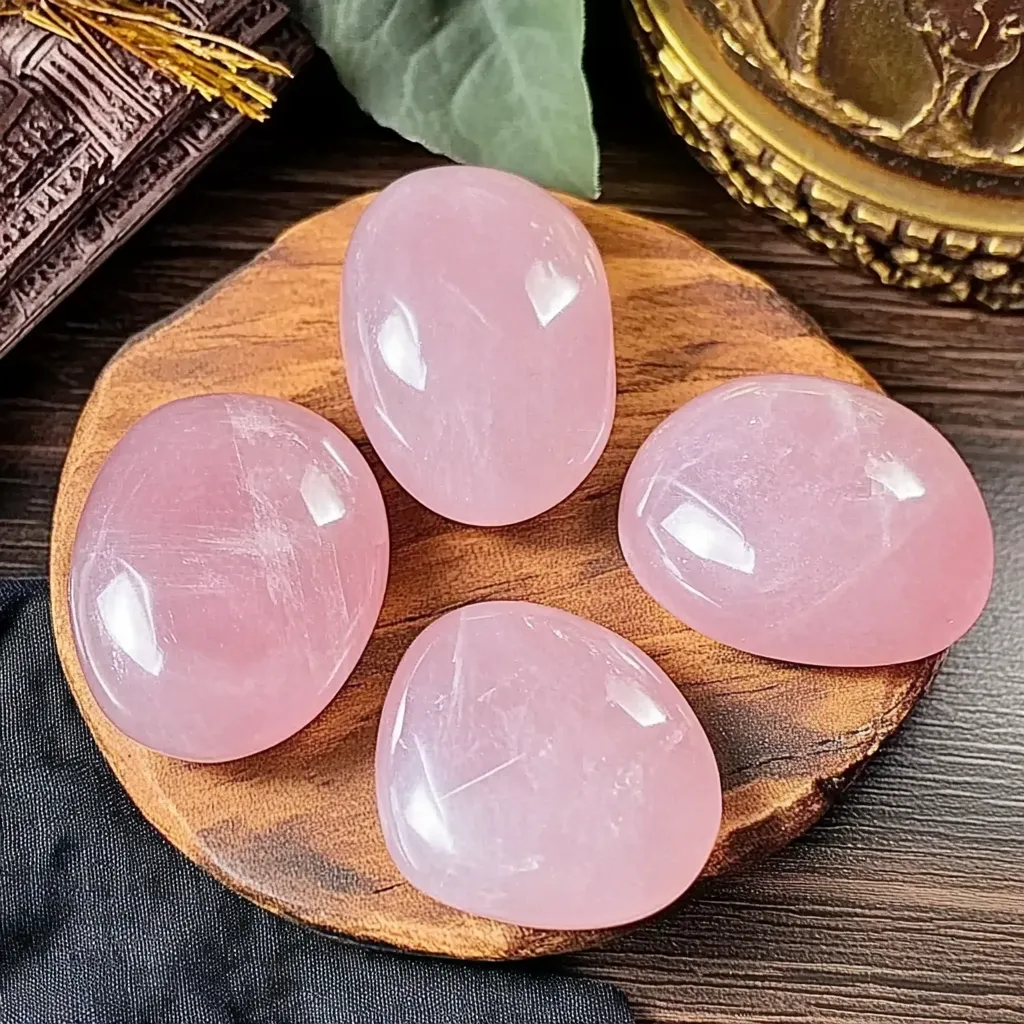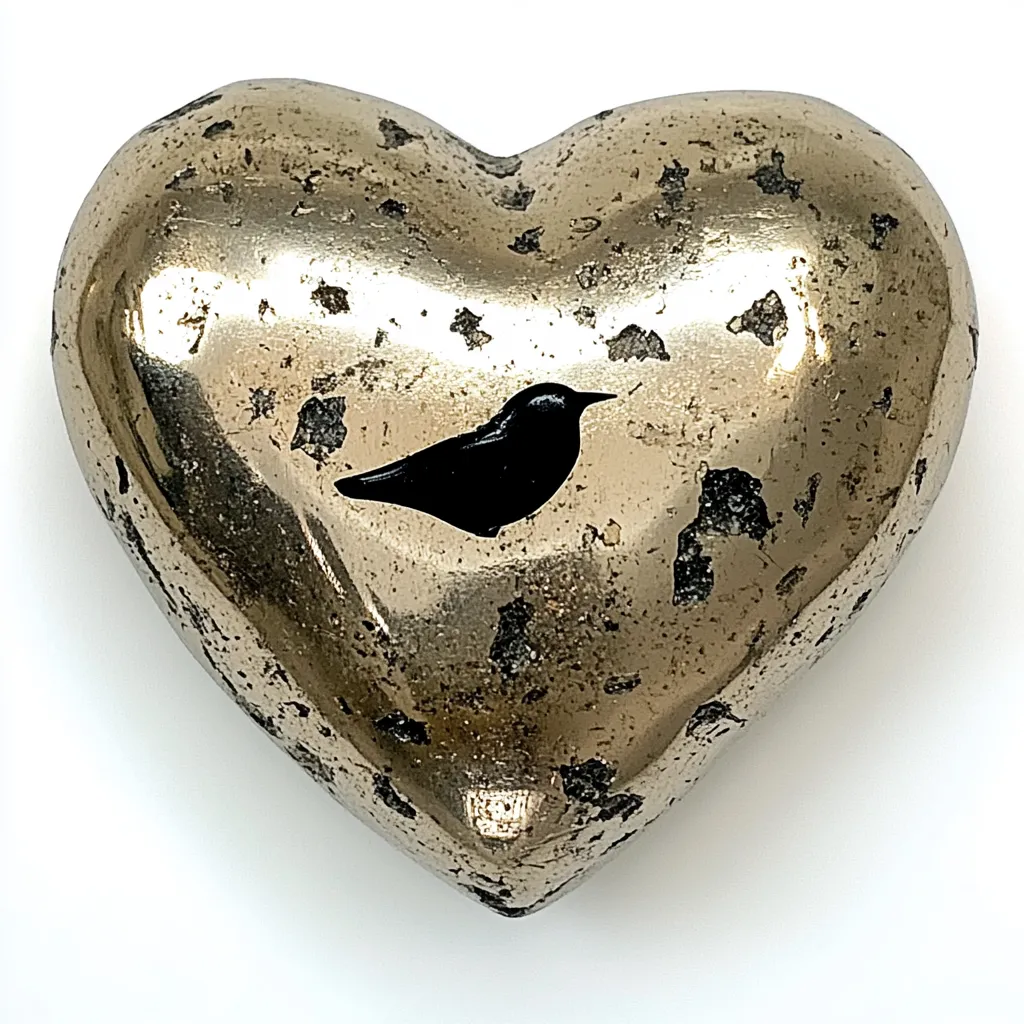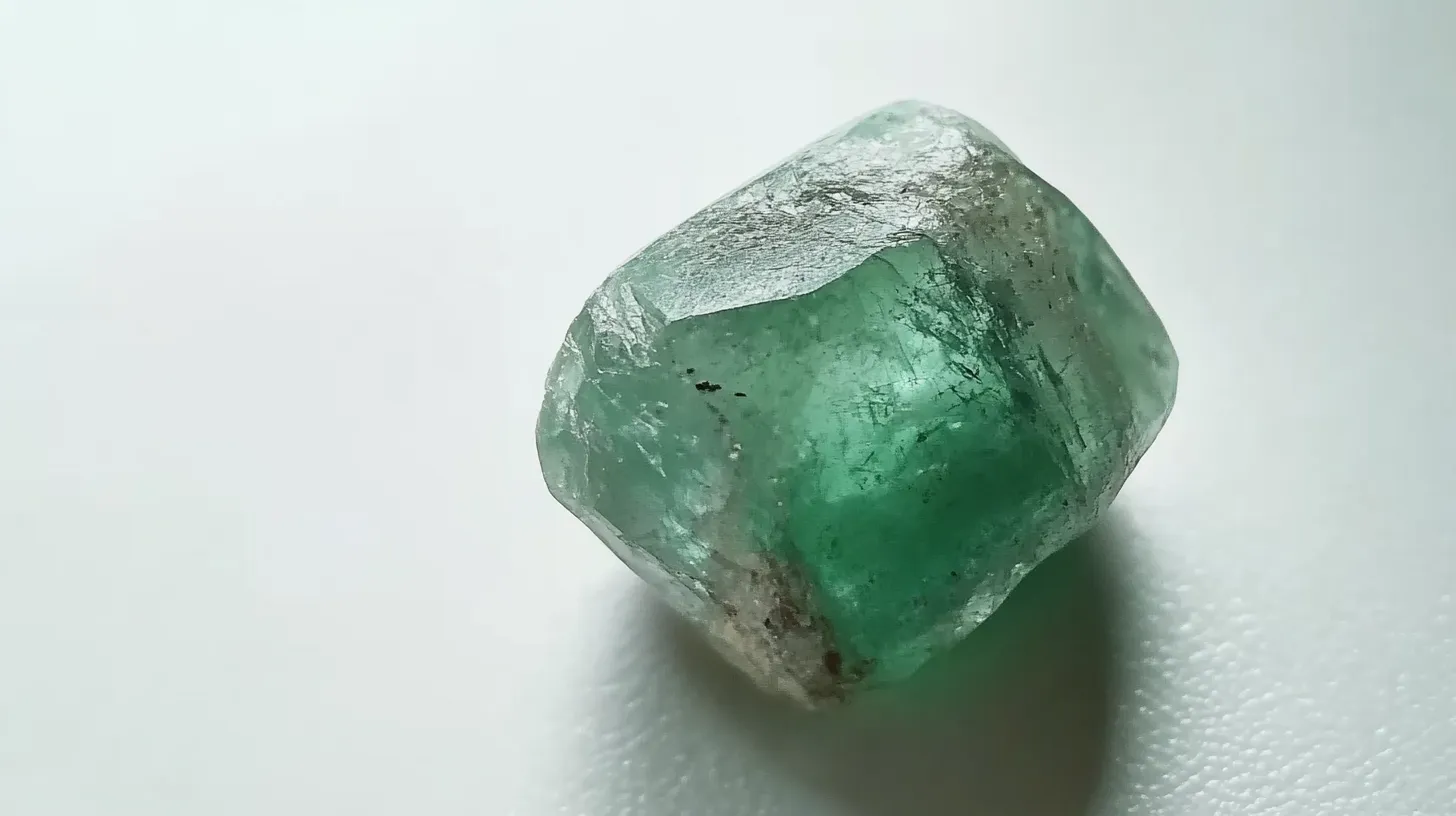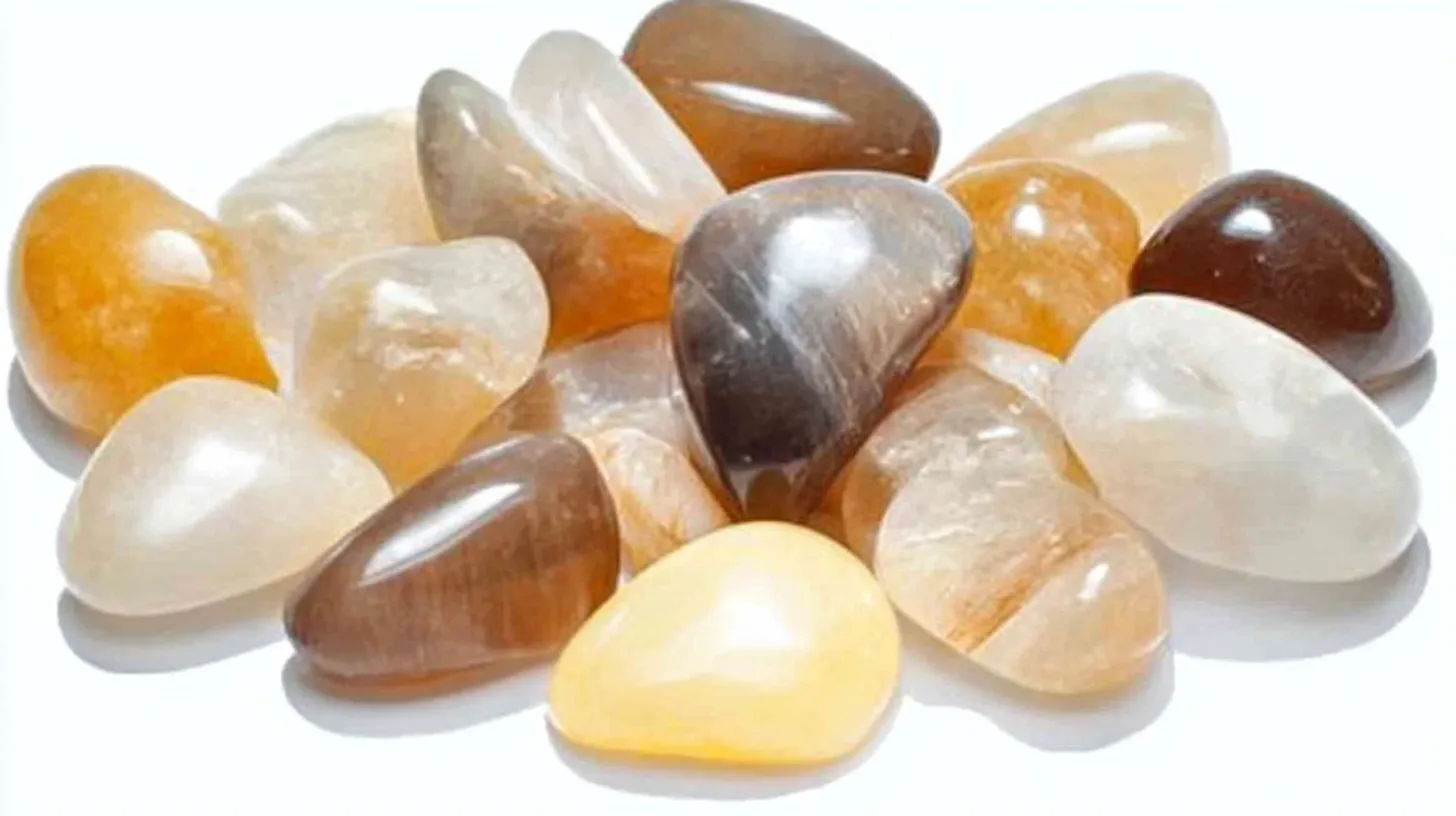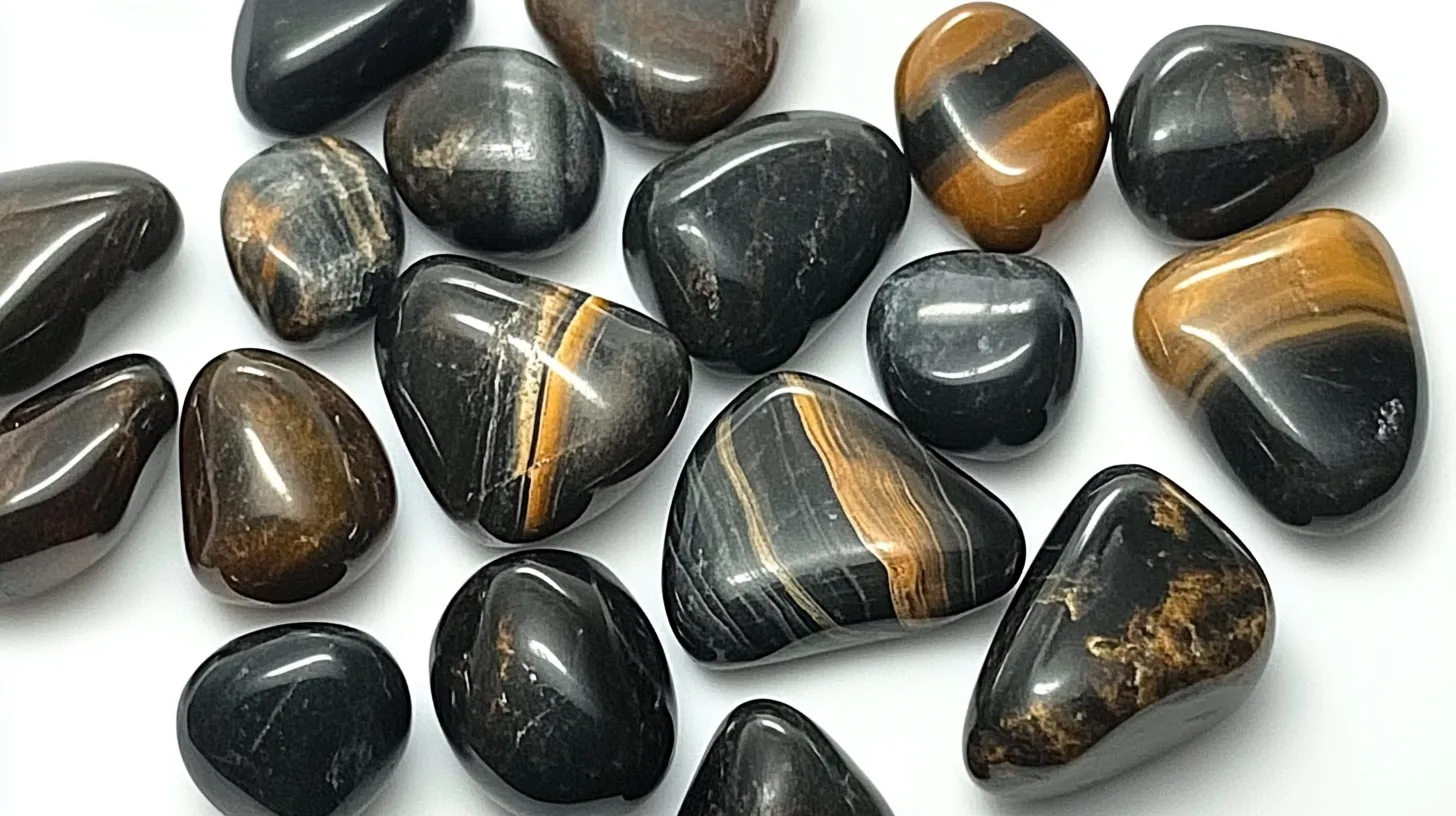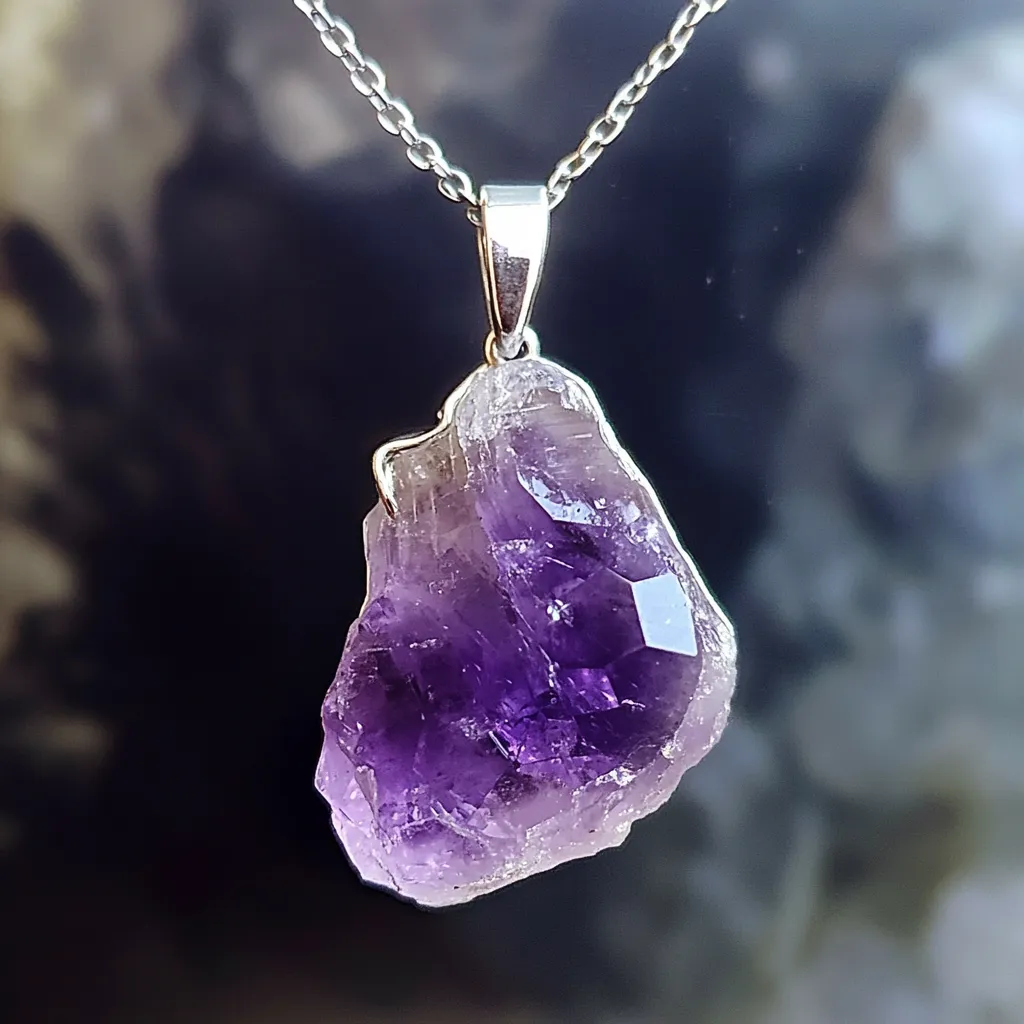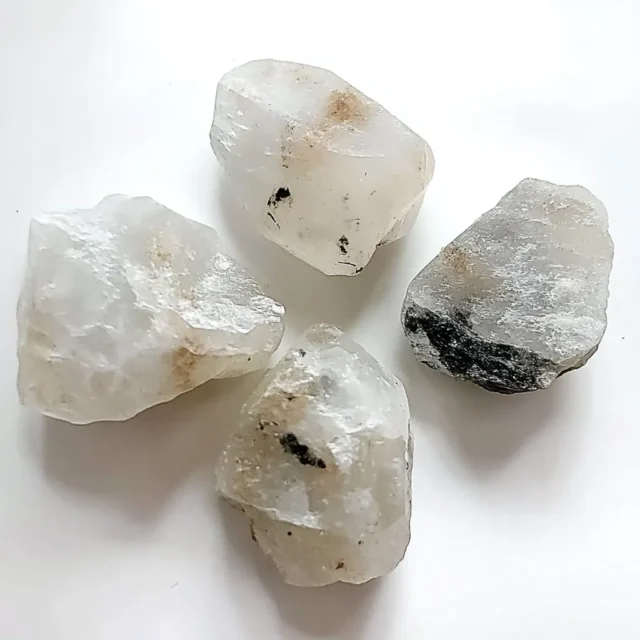

Scientific Properties of Moonstone
Moonstone is a member of the feldspar mineral group, the same family that makes up over 60% of the Earth’s crust. What makes moonstone special is a unique optical occurrence called adularescence, which is a silvery or blue light that seems to float just under the stone’s surface. This glow, which is reminiscent of moonlight, is what gives the gem its name.
The moonstone consists of two different kinds of feldspar—not just any kinds, but two kinds that are beautifully layered together.
High-quality moonstones are becoming increasingly rare. The best specimens—historically mined in Sri Lanka and India—now often come from Myanmar, Tanzania, and Madagascar. Be wary of synthetic or imitation moonstones, and always check for authenticity.
Moonstone Colors
The majority of individuals envision moonstone as being white or pearly, yet its color spectrum is actually quite diverse. You will encounter blue moonstones, peach, gray, green, and even rainbow-colored. Each hue holds a distinct energy, which is why crystal healers find it versatile. Why moonstone, then? Here are a few reasons:
| Moonstone Color | Meaning and Benefits |
|---|---|
| Silvery Blue | Brings peace |
| Peach | Fosters acceptance and helps you express yourself |
| Green | Supports abundance and financial freedom |
- Blue Moonstone: Frequently extracted from Sri Lanka, it’s cherished for its profound, incandescent radiance—perfect for spiritual enlightenment.
- Peach or Cream Moonstone: These warmer tones have a quality that feels emotionally comforting, often utilized for purposes of inner healing.
- Rainbow Moonstone: Despite what its name might suggest, it is actually a form of labradorite with multihued flashes. It is associated with creative expression and equilibrium.
Labradorite: Most commonly found in Canada, this feldspar mineral exhibits a spectacular display of colors. It is associated with intuition and the balancing of extremes.
Color may also vary somewhat based on the cutting style of the stone and the way light travels through it. One popular cut, especially for stones that exhibit adularescence, is the cabochon. This cutting style produces a smooth, rounded stone that, when placed upside down, will almost always result in a more brilliant and luminous piece of jewelry.

Moonstone Benefits for Spirituality
On a spiritual level, moonstone is frequently referred to as the “gem of new beginnings.” This is a stone that many crystal lovers—myself included—embrace during times of transformation and emotional development. It is believed to bolster not only emotional clarity, but also the feminine energies and inner strength that each of us possesses.
Moonstone is particularly notable for its association with the moon and the divine feminine. Some practitioners use it in balancing hormonal cycles; others claim it boosts intuitive abilities and empathy. Despite the lack of scientific evidence, we shouldn’t dismiss the calming effect many people report when wearing moonstone.
Could it be nothing more than a placebo effect? Maybe. But holding a softly glowing gem and feeling its glow during this time we call ‘‘now’’ is all about feeling more centered, more right with ourselves. And that alone makes it a worthwhile exercise.
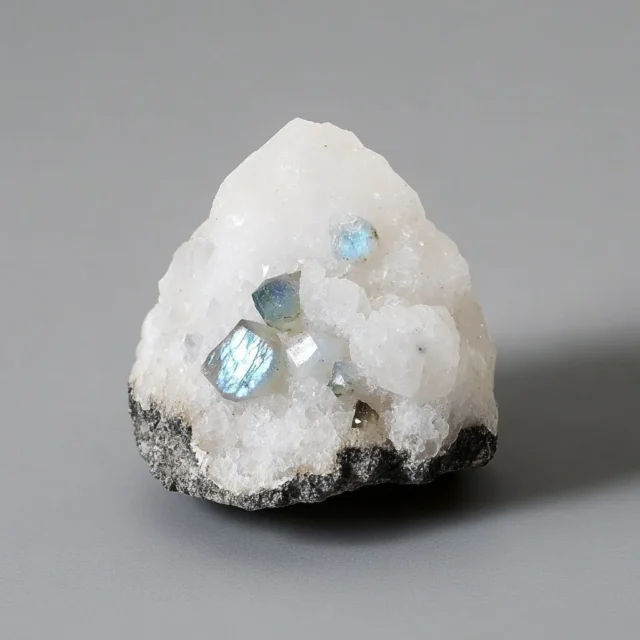
Meditation with Moonstone
During meditation, moonstone can help establish a deeper link to the subconscious. A polished moonstone is my go-to companion for lying down and placing on either my heart chakra or third-eye chakra. It feels particularly good to receive its energy there, though you may also find it nourishing for the mind, body, and spirit in a more centralized or seated position where you’re hugging your knees.
You don’t need to practice meditation for a long time to benefit from it. Give this approach a shot:
| Step | Action |
|---|---|
| Position Yourself | Find a comfortable position with moonstone in hand |
| Breathe In | Take a deep breath and imagine the stone’s radiance moving through your being |
| Breathe Out | Release tension and mental chatter with every exhalation |
Some people follow up their moonstone meditation with journaling. They do this because it helps them articulate the thoughts and insights that come to them during meditation. While their journaling is not necessarily a form of expression, it becomes a way to translate into written words that first take form in the mind.

Moonstone and Feng Shui
More than merely a lovely crystal, in Feng Shui, moonstone conveys something much more—a clear symbol of emotional balance, peace, and healing. This mineral is often affiliated with the Water element—the one most linked to flow, intuition, and purification. Moonstone is an excellent crystal to employ if you want to ameliorate a specific emotional issue. Placing it in your space will reduce roiling feelings and help restore harmony, especially in areas where the energy is not moving.
| Feng Shui Element | Symbolism | Benefits |
|---|---|---|
| Water | Flow, Intuition, Purification | Emotional balance, Peace, Healing |
I once gifted a friend with a moonstone, and she’s the one who really brought my attention to the stone’s soothing properties. This friend of mine was (and still is) an insomniac. She kept the moonstone near her bed. Though I can’t say the stone worked like magic, my friend did say that the room felt much calmer, and I’m not sure if it was just my friend’s overactive brain at work, but I find that moonstone’s charm is indeed very subtle. Whether you believe in its charms or not, it seems like a great stone to keep around for a calming presence.
Moonstone and Zodiac
Not every gemstone has a close connection with all zodiac signs, but moonstone has a special resonance with Cancer, Pisces, and Scorpio. These water signs are intuitively and emotionally deep—qualities that moonstone enhances. The moon itself rules Cancer, providing a unique alignment with this gem. Many Cancers wear moonstone jewelry to stay emotionally grounded and to navigate their moods with greater ease.
| Zodiac Signs | Connection with Moonstone | Benefits |
|---|---|---|
| Cancer, Pisces, Scorpio | Enhances intuition, Emotional depth | Emotional grounding, Mood regulation |
However, this stone doesn’t only apply to water signs. Those seeking emotional insight or a tighter bond to their inner monologue can gain from this stone. For example, when it comes to astrology, the sign of Virgo is often associated with overthinking. Moonstone helps these individuals soften their mental rigidity and move toward a more heart-led decision-making process. This stone is almost like having a lunar guide on your wrist or in your pocket.

Place to Put Moonstone
If you are pondering where to store your moonstone, think about what you want it to help you with. If you have a specific intention, your moonstone will function more effectively. It will be a better moonstone for you if you have a reason for having it. So it’s not just about where to keep it; it’s about why you’re keeping it and what you’re moonstone-ing for.
When considering energy, the southwest area of your home is the best for fostering relationships. Placing moonstone in that corner could help with not only communication but also with penchants for empathy.
If you meditate or do tarot, consider having a moonstone nearby as you do those things. It’s about making this crystal part of your practice.
Guide to Cleanse Moonstone
Any crystal, such as moonstone, can soak up energy and, occasionally, can use a little refresh. Because moonstone is associated with the moon and the feminine divine, it is best to cleanse this crystal under the moon’s gentle, silvery light. For a truly moonlit crystal, place your moonstone on a windowsill or outside to bask in the full moon’s light overnight. Such an arrangement feels almost ceremonial, and in some cultures, it is. The secret to preserving the stone’s radiance is avoiding the kind of cleansing that subjects delicate moonstone—much like skin—to harsh solar rays.
| Cleansing Methods | Description | Benefits |
|---|---|---|
| Moonlight | Place on a windowsill or outside overnight | Gentle energy cleanse |
| Smoke (sage/palo santo) | Use smoke to cleanse the stone | Removes stagnant energy |
| Sound Bath (singing bowls) | Use sound frequencies to cleanse the stone | Restores balance |
| Spring Water | Hold in hands and place in spring water | Personal mindfulness |
There are various methods for cleaning moonstone. One method is to use smoke from sage or palo santo. Another way is to give the moonstone a sound bath using singing bowls. A more personal method involves holding the moonstone in both hands and placing it in a bowl of spring water. While doing this, the holder sets an intention to cleanse the stone of any stagnant energy. Cleansing is not just for the stone; it is also a moment of mindfulness for the holder.

Questions and Answers
More Facts About Moonstone
Opal vs. Moonstone
Opal and moonstone, two enchanting gemstones, are unlike one another in terms of their properties and resonance. Opals possess a vivid and almost electric play-of-color that surpasses that of any good opal, making moonstone a less competitive player in terms of beauty. This is not to say moonstone isn’t beautiful, for it has an alluring, almost mystical quality thanks to its largely untapped potential. And yet if we were to judge these two stones purely on their appearances, the title of “most aesthetically pleasing” would undoubtedly go to opal. And as if that weren’t enough, opals aren’t just pretty. They have some powerful metaphysical properties.
White Moonstone Gemstone
The most common type of moonstone is white moonstone. Its appearance is that of a translucent, milky substance with a glorious, almost unearthly glow. It’s quite a beautiful sight, really. Most people think of white moonstone when they think of gemstones.
It’s a stone in popular culture, and its mention often directs one’s thoughts to its properties of having calming and soothing effects; for what reason, I don’t exactly know. However, people frequently mention these functional properties. So, yes, it is calming; it is soothing; it is associated with the mystical qualities of intuition. Whether one is or isn’t in the belief system associated with moonstone, in my opinion, that’s just a gorgeous set of qualities.
Moonstone Mohs Scale
Moonstone has a hardness of 6 to 6.5 on the Mohs scale, placing it in the mid-range for gemstone durability. It isn’t anywhere near as hard as the top three stones—diamond, corundum, and topaz—but it is relatively resilient to scratches and damage when handled with care. Its softness renders it perfect for jewelry, particularly in pieces intended for frequent wear. Earrings, for example, are a good choice for moonstone, but a moonstone ring would make me wary because of its close proximity to the hard surfaces of the hands.
Moonstone Hardness and Durability
| Property | Value |
|---|---|
| Hardness | 6 to 6.5 (Mohs) |
| Durability | Moderate |
| Best Jewelry | Earrings |
Real Moonstone
The unique adularescence of real moonstone sets it apart from imitations. Adularescence is the way a soft, glowing light seems to move across a stone’s surface when you’re looking at it from varying angles. Genuine moonstones are usually white or gray, with or without rainbow inclusions. They also come in more earthy tones like copper and brown. When buying a moonstone, look for authenticity and high quality in terms of appearance and sheen. Authentic moonstones come from some of the places around the world that are known for producing the best gemstones, including India and Sri Lanka.
Moonstone Rainbow
“Labradorite Moonstone” is the name given to various moonstone that has a beautiful play of colors, with blue, white, and silver being the most commonly seen tones. As you might have guessed, this play of color is due to light interacting with different layers of the stone and is more accurately described as an almost heavenly iridescence. And while this type of moonstone is popular enough and beautiful enough for normal gemstone purposes, it’s probably more beloved within spiritual circles.
Moonstone Rainbow Variations
| Type of Moonstone | Color Tones | Characteristics |
|---|---|---|
| Labradorite Moonstone | Blue, White, Silver | Iridescent, Spiritual |
Gray Moonstone Meaning
Gray moonstone, with its calm and understated beauty, is believed to hold the essence of balance and harmony. Its soft, silver luminescence represents neutrality. It offers a soothing influence over those in its proximity. For the most part, the moonstone’s calming effects are associated with the emotional type of stability one may find when working with gray moonstone. The nurturing side of the moonstone is, for many, a facet of its personality. When one thinks of the moonstone aspect of personal growth and mental health, the symbols of
Moonstone Value
Moonstone can be worth different amounts depending on a few factors, like color, clarity, and size. When you look into the worth of moonstone, you need to first consider the individual gem’s qualities. Moonstones are more valuable when they have strong adularescence, which is the glow that seems to come from deep within the moonstone, giving it a wonderful, dreamy quality. Moonstones are also more valuable when they are large. Moonstone jewelry is less expensive than diamond or sapphire jewelry, but its allure makes it desirable. It’s also fairly easy to find. Although it’s not as expensive as rare gemstones, it’s often used in jewelry. Whether you buy it for its beauty or its metaphysical properties, moonstone offers excellent value.
Black Moonstone Heart
Black moonstone, with its dark, enigmatic shade, stands as a powerful agent of transformation and protection. Donning a black moonstone heart is a way to make a statement about love, emotional healing, and strength, since the affection between the wearer and the stone is sure to imbue it with even more intimate significance. Black moonstone is an excellent choice for a stone to use in healing, since it is often used to release past trauma and work through emotional recovery. Take a moment to breathe deeply and try to embody the true meaning of this meditative stone as you appreciate its grounding, calm energy that is so perfectly suited for personal growth and finding one’s inner self.

